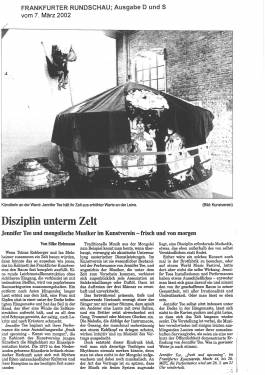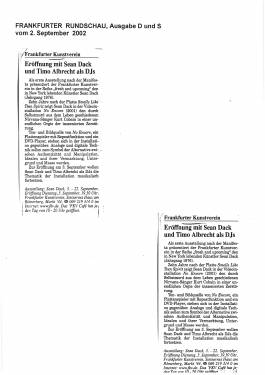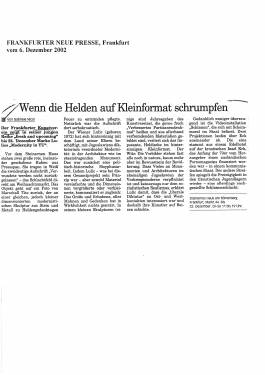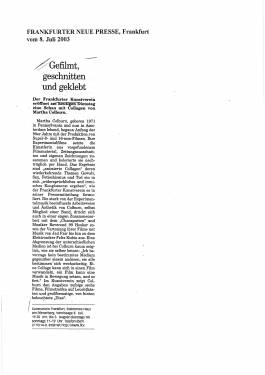Fresh and Upcoming
2002—2003 Frankfurter Kunstverein EXHIBITION
Mar 5, 2002 to Dec 16, 2003
The exhibition series has shown since March 2002 each month one “young” artist. International artists at the beginning of their artistic career, who have up until now been seen mainly in group shows or in gallery exhibitions, have the possibility to present their work individually.
Sean Dack
Sept 3 to 22, 2002
In the early nineties many Seattle rock bands labeled by the media as “grunge” attained world wide popularity, and this movement was celebrated as a triumph for alternative music culture. Kurt Cobain, the lead singer of Nirvana, which was Seattles most popular band, became an idol for many youths: He helped shape the “lifestyle of an entire generation” (Bravo, 1995).
Ten years after “Smells Like Teen Spirit” the artist Sean Dack ( born 1976, lives in New York) presents Kurt Cobain in an infinite orgy of staged destruction in his video installation “No Encore” (2001). The clips of Kurt Cobains performances show the repetition of tired rock music cliches. The myth of Kurt Cobain as being rock musician who couldn’t cope with his own popularity, was long since a predictable part of the music industry. The media hype about Seattle and “grunge” disappeared as soon as Cobain committed suicide in 1994. In the installation “No Encore” audio and visual sources, a record player set on repeat and a DVD-player, are located across from each other. Analog and digital technology become symbols of the alternative between authenticity and manipulation, ideals and their commercialization, the underground and the mainstream. A duality which marks the transition from alternative culture to the mainstream.
Henning Bohl
Oct 1 to 27, 2002
The search for new ways of life can lead to very different, even opposing aesthetic results. A man-made pond revives the dream of a private idyllic garden. Pictures of villages call to mind the days of organic farming in the context of peace and environmental movements.
Even the practice of new building (“Neuen Bauens”) in architecture aspired to the improvement of the quality of living. In contrast to a conservative alternative of explicitly integrating nature, a sober functional form of design has developed.
Henning Bohl’s (*1975, in Oldenburg, lives in Berlin and Frankfurt am Main) installations, collages, and drawings refer to similar original ideas and connect seemingly conflicting designs often relating to an assemblage influence by utopian ideas. The pond in the middle of the exhibition is made of arranged squared timber and recalls memories of Bauhaus terrace architecture. In another version of the pond the romantic element disappears completely. The pond transforms into an abstract form collapsed and freed from its original purpose. The previously mentioned villages in Bohl’s works only exist as a netlike structure. Cut out and without a canvas on picture frames, the more conservative city blocks transform into a filigreed constructivistic aesthetic. In Henning Bohl’s works nature and style are not opposites, but rather an expression of collective basic needs.
Henning Bohl studied under Professor Bayrle at the Städelschule Frankfurt am Main.
Marko Lulic
Dec 3 to 22, 2002
The main theme of Marko Lulic’s (*1972) works is modern ideologies.
For the project “Modernity in YU”, he specifically reflects on repertoire forms of the official aesthetic of the former Yugoslavia. The Austrian, Lulic, who spent some of his youth in Yugoslavia, takes a look at relics of a no longer existing communist state through his sculptures and video projects. These relics represent former monuments and heroic manifestations of strongly believing in the future. In the meantime the future has become the past.
Many memorials with their clear rhetoric of political validation in the former Yugoslavia exist, yet among the collective consciousness of the people this no longer exists. Marko Lulic has thoroughly studied the communist aesthetic. He has critically modified monuments ignoring their ideological meaning and sublime gestures, while filtering out the potential for modernity from concrete sculptures embodied with the power of the state. He reproduces original large works in small models whereby he simultaneously upholds and reflects their aesthetic. The immense and sublime become small sculptures out of papier-mâché, the massive becomes fragile, and the public private. Through this transformation, Lulic’s “improved partisan monuments” are temporally and visually shifted and represent the avant-garde moment, which is part of Yugoslavia’s official aesthetic as well. In the video installation, “Schlamm” from 2001, pictures of a prestigious hotel from the magazine “Penthouse” in Yugoslavia are shown in contrast to staged scenes from former youth camps. This confrontation deals with the double standard within the politics of socialism. This form of entertainment, a capitalistic “porno hotel” undermines the celebrated in-tune-with-nature-feeling of nationalism in the youth camps. Although in both one can surely find corresponding aspects of liberal attitudes toward the body.
Tue Greenfort
Nov 5 to 24, 2002
Tue Greenfort (*1973) discovers the details of city life, which are largely unknown or go unseen due to their normalcy. In his work, Greenfort deals with these kinds of situations in space and in everyday life and reveals the structures behind urbanity through small changes or mechanisms. With the help of artistic intervention, occurrences become visible and their existence questioned. With different projects in the urban area of Cologne and Frankfurt, the artist shows, for example, how city architecture defines public space or how private properties are divided. By adding steps to walls or fences, he creates new or simplified sidewalks.
For the exhibition at the Kunstverein Frankfurt, Greenfort looks at the constitution of space and its ascribed functions. Here he uses the surrounding area, three different spaces in the vicinity of the Kunstverein Frankfurt: the public space of the Römerberg, the semi-public area in the café of the Kunstverein, and the vaulted room, designated for exhibitions from the series “Fresh and Upcoming”. Tue Greenfort totally refrains from the originally planned exhibition room and closes off the room with a wall. Instead, he integrates his work into the café of the Kunstverein as well as the public area outside. In both cases he changes their existing lighting situation. As Greenfort adds a light switch to a street lamp, the café’s design in the Kunstverein is completed with a self-made lamp.
Tue Greenfort presents light as an essential element for the designing of space and through his presentation he emphasizes the interaction between the function of the room and the meaning of its objects. Had the lamp been exhibited in the exhibition room, it simply would have been viewed as “art”. But now it is part of the designed space.
Tue Greenfort studied at the Städelschule Frankfurt am Main under Prof. Bayrle.
Omer Fast February
5 to 23, 2003
The video installation, “A Tank Translated”, from Omer Fast (*1972) shows segments of conversations with four young soldiers from an Israeli tank troop on four monitors. The monitors displayed on different levels represent the soldiers’ different positions in the tanks.
The soldiers give various descriptions of their conditions in the tanks and how they view their surroundings during deployment. The film material appears to have a documentary character. However, Omer Fast intervenes with the subtitles of the interviews conducted in Hebrew. The military terms from two interviews are exchanged with non-military expressions in the subtitles. In the other interviews single words disappear completely or the opposite of the intended meaning is used.
The viewer is misled about what military operations may look like through the content of the conversations. Omer Fast plays not only with the boundaries of the soldiers’ state functions and with their personal lives, but also looks at the relationship between the civilian population and the military, war and media or at the relationship between reality and manipulation. Existing sentence structures are loosened to give new meanings, which can not be corrected through the existing relationship between picture and text. The obvious manipulation of translations visualizes not only the possibility of change in a lingual sense but the possibility of new understandings. The subtitles alternate in English and German.
Omer Fast was born in Israel and lives in Berlin and New York.
Flammencommando
Mar 3 to 24, 2003
Shannon Bool
Apr 1 to 27, 2003
Adolf Loos argued that the rejection of the ornament is due to its displacement within contemporary cultural discourse. Since the ornament is no longer organically related to our culture, it is also no longer an articulation of our culture. Hence, the ornament becomes outdated hindering people in their cultural development.
Shannon Bool (*1972) shows in her works a continuous preoccupation with the function of the ornament. Contrary to Loos’ postulated missing correlation between ornament and contemporary culture, Bool understands the ornament as a link to medial aesthetics as such.The fragmented images found on many overlapping levels in drawings, collages, and murals reveal a patchwork of subjective influences and experiences. Modern transfigurations of a romanticized nature-orientated lifestyle like in the American television series, “Lassie”, play for example upon cliches of her birthplace, Canada, and combines with prototypes from fairy tales and childrens’ books. Military motives shatter this reconstruction of an “ideal world”. The ornamental fragments integrated into the images create a link between different levels of reality. They rupture the perspective of figurative motives and transfer them as a construction. The individual motives remain fragments of an uncertain reality woven into a carpet of associations.
René Zeh: Inseln
May 6 to Jun 22, 2003
René Zeh’s installations are not finished. Fractions and differences appear not only where elements of his previous work become a part of new contexts but also in the way Zeh deals with his subject matter. Fractions and differences rather than a closed system are presented to the viewer. René Zeh (born 1973, lives in Düsseldorf) transforms the spatial conditions for the exhibition in the Kunstverein Frankfurt.
Two very different rooms in the basement of the Kunstverein Frankfurt are connected through Zeh’s transformation. Instead of standardization the architectural differences become more apparent. The visitor is forced to uncomfortably get past a half landing where the stairs once were.
The transformation suits the thematic discussion which takes place in the rooms. The title of the exhibition, “Islands”, sums up the individual objects of René Zeh’s interest. Real sanctuaries, like lifestyles, fashion, or holidays represent the longing for escape and change but which loose meaning in clichés and triteness. Zeh doesn’t leave out his own reflection on the topic. The art is presented as superficiality in the form of hundreds of invitations. The emptiness behind the dream of the hut in the South Seas is repeated through the negation of each content in the amount of invitation cards.
In René Zeh’s work various ways of life overlap. He uses their tension to grasp the divergence of reality instead of setting them up against each other.
Martha Colburn
Jul 8 to Aug 3, 2003
Martha Colburn (born in Pennsylvania 1971, lives in Amsterdam) started producing super 8 and 16 mm films in the early nineties. Her experimental films are made out of found film material, newspaper clippings, and from her own drawings which she then colors by hand. Animated collages result whereby reoccurring themes like violence, sex, fetishism and death render a peculiar contradictory ironic conglomerate.
The symbols and clichés used in her films are freed from their original meaning through their quantity and combination and are woven into their own distinctive carpet of diverse influences. Martha Colburn’s method of working and aesthetic is heavily influenced by experimental music, as she herself is in a band. She has closely worked with Chaospoeten and with the musician Reverend 99 Hooker and adds sounds to her films with musical elements from Jad Fair to the electronic musician Felix Kubin.
It is nearly impossible to differentiate one specific type of medium from another within Colburn’s work, as she states herself; “I don’t favor any one medium over the other, they all feed one another. A collage can set into motion in a film, a film can set into motion a song and so on.” Thus her films are not only shown at film festivals, but also at concerts, audio visual performances and in room installations as visuals.
With this sort of backdrop it is logical that film material is used as an object in an exhibition at the Kunstverein Frankfurt. Besides the compilation of six films, Colburn presents film strips from her own films in light boxes and large formats lit up transparencies. The moment of movement is taken from the animated collage and is projected onto a surface. Similarly as collage and music are closely related in the films, so are the boundaries between film, photography, and object merged.
Opening with Performance:
October 8, 2003
Michael Mahalchick
Oct 9 to 26, 2003
In the series “Fresh and Upcoming” the Frankfurter Kunstverein is showing Michael Mahalchick (born 1972, New York). Mahalchick works sculpturally as well as performativly. The exhibition will consider the relationship between both aspects of his artistic activities. It will begin with a performance where the audience will be included; documentation thereof will then be a part of the following exhibition.
In the production process as well as in the perception of Michael Mahalchick’s sculptural and per-formative works are subjected to an ongoing metamorphosis and displacement of contexts. Here conflicting associations surface out of sewn and strung objects intervening into one another in a specific way. Some works appear to be bound extremities, genitals, or tied-up creatures while others bring the materiality or color of the pieces of cloth in the foreground and become amorphous fragile abstractions. Mahalchick creates a scenario from aspects like sexuality, stereotypical roles, self portrayal, fetishism, and imagination making it is difficult to judge if it is drawn from shortly before or after a dramatic outburst.
Up against the redeemed language of the objects, the audience is confronted with the extravagant and flamboyant world of Michael Mahalchick’s performances. In the performance especially created for the Frankfurter Kunstverein Mahalchick lures the audience to play a game of needs like differentiation, self portrayal, and concealment. The performance exaggerates the division between actor and viewer to gradually dissolve this division and resort to their opposites: The audience at first can only follow what is going on in the exhibition room on one monitor and are asked during the performance to enter the exhibition room to take part themselves in the performance. Undoing the dichotomies from the inside and outside occurs within the performance corresponding to the dispersal of production, viewer perception, expectations and fulfillment just as with the cloth objects from illusion and reality.
Simon D. Møller
Nov 4 to 23, 2003
The series “Fresh and Upcoming” in November presents new works from Simon Dybbroe Møller (born 1976); a student at the Städelschule in Frankfurt am Main. The Danish artist deals with the historical and structural conditions of urbanity and forms of living in his work thus far. In his various installations he works with forerunners like avant-garde design from the 20s and 30s.
For the exhibit in the Frankfurter Kunstverein, his works take everyday situations and conditions as a starting point to question their given mechanics through slight modifications and to fathom their potential transformations. In the video, “Very tomorrow, very yesterday”, it is unclear at first if the visible traffic routes are real, since they don’t lead anywhere and therefore have no purpose. In fact, it is about a planned road network of a yet non-existent city district. However, the idea of something new fades as soon as reality is recognized. The geographic location and its surroundings clearly refer to further development area whose future design is apparent, wherefore additional explanation hardly seems necessary. In the video, people surface successively and cross the street from a profane connecting path to an abstract image of communication and city structure. Precisely, it is the simplicity in this sober reduction of the city to its basic structure which refers to the actual complexity of urbanity. Møller continues with the image of a predetermined structure in his series of works on paper. The challenge itself becomes the work’s concept with a subtle change of the lines on the grid DIN A4 paper. The words, which become visible within the structure of the grid paper, emphasize the existence of various perspectives and realities. This could be representative of Simon Dybbroe Møller’s artistic endeavors.
Fowler / Campbell
Dec 9 and 16, 2003
The last exhibition in the series “Fresh and Upcoming” took the form of two film events arranged by the artists Luke Fowler (born 1978, lives in Glasgow) and Duncan Campbell (born 1972, lives in Glasgow). The documentaries in the program for the most part reconstruct punk rock or avant-garde music through individual musicians.
Each evening a new film by one of the artists will be juxtaposed with an older film. With the title Outsider Documentary Fowler and Campbell not only refer to similarities in the content of the films – the outcasts of music history – but also to ways of making documentary films, which attempt to explore the possibilities and boundaries of the genre of documentary filmmaking.
The Way Out (Luke Fowler/Kosten Koper, UK 2003, 33 mins.)
This collage-type documentary gives an unusual insight into the creative output of one of the mavericks of the London DIY punk scene, L Voag. In this work Fowler has put together a wealth of images from different sources to create a subjective and experimental portrait of the musician. L Voag was an overlooked, but productive and experimental loner of the London punk rock scene. In the period from 1978 till 1983 he took part in 14 musical projects each time under a new pseudonym. This anti-careerist strategy allowed him to evade criticism both from the press and his fans, while offering him complete musical freedom.
All That Jazz (Olivia Lichtenstein/ BBC, UK 1985, 45 mins.)
Filmed without Soviet permission with amateur equipment, this film follows the avant-garde jazz/rock composer Sergei Kuryokhin and his band the Pop Mechanics. Kryokhin refused to collaborate with the authorities and play officially approved music. He was determined to be a non-conformist, but nonetheless kept a non-political attitude, neither being pro- nor anti-soviet.
Falls Burns Malone Fiddles (Duncan Campbell, UK 2003, 30 mins.)
Duncan Campbell has, for this documentary about West Belfast youth, used material from two photographic archives in Belfast. On the background of the loosely put together material, the narrator muses over the rhetorics of youth, liberation politics and the formal problems of documentary film.
Shellshock Rock (John T. Davies, UK 1979, 60 mins.)
Shellshock Rock documents the activities of the most important Northern Irish punk label “Good Vibrations”, as well as its founder Terri Hooley and his bands. The film highlights punk rock’s tendency to regionalism, which here means that the music and lifestyle, rather than being the cause of mere violence, functions as a refuge from bitter sectarianism and religious terrorism.

EXHIBITION FOLDER
Artists: Sean Dack, Henning Bohl, Marko Lulic, Tue Greenfort , Omer Fast February, Flammencommando, Shannon Bool, René Zeh, Martha Colburn, Michael Mahalchick, Simon D. Møller and Fowler / Campbell
The foregoing texts and images are provided and copyrighted by: https://www.fkv.de/en/


























